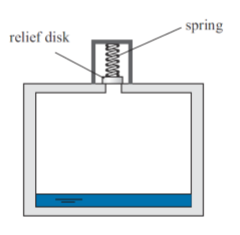A pressure cooker cooks a lot faster than an ordinary pan by maintaining a higher pressure and temperature inside. The lid of a pressure cooker is well sealed, and steam can escape only through an opening in the middle of the lid. The pressure relief valve consists of a spring-loaded disk that is positioned over this opening. Consider that a certain portion of a pressure cooker is initially filled with water and put on top of a stove (State - 1). Heat is added just until the pressure relief valve opens (State 2). Heat continues to be added until all of the liquid disappears (State 3). Using the knowledge that you learned in the Thermodynamics-I Course, analyze the operation of this pressure cooker thermodynamically (i.e. find the intensive properties of water such as temperature, pressure and quality, mass of liquid water in the cooker, mass of water vapor that has passed through the pressure relief valve, and time passed for various stages of its operation). Operation and design parameters of the pressure cooker include volume of the cooker, initial volume of water, heat input rate, surrounding pressure, disk diameter, mass of the disk, spring constant, the change in length of the spring, etc. Using resources (e.g. textbooks, reports, websites, etc.), give appropriate numerical values for the operation and design parameters of the pressure cooker and find the results for each stage. Show the processes on a T-v diagram. List any assumptions that you make. Comment on your results considering a practical application.
A pressure cooker cooks a lot faster than an ordinary pan by maintaining a higher pressure and temperature inside. The lid of a pressure cooker is well sealed, and steam can escape only through an opening in the middle of the lid. The pressure relief valve consists of a spring-loaded disk that is positioned over this opening.
Consider that a certain portion of a pressure cooker is initially filled with water and put on top of a stove (State - 1). Heat is added just until the pressure relief valve opens (State 2). Heat continues to be added until all of the liquid disappears (State 3).
Using the knowledge that you learned in the

Trending now
This is a popular solution!
Step by step
Solved in 7 steps with 28 images


